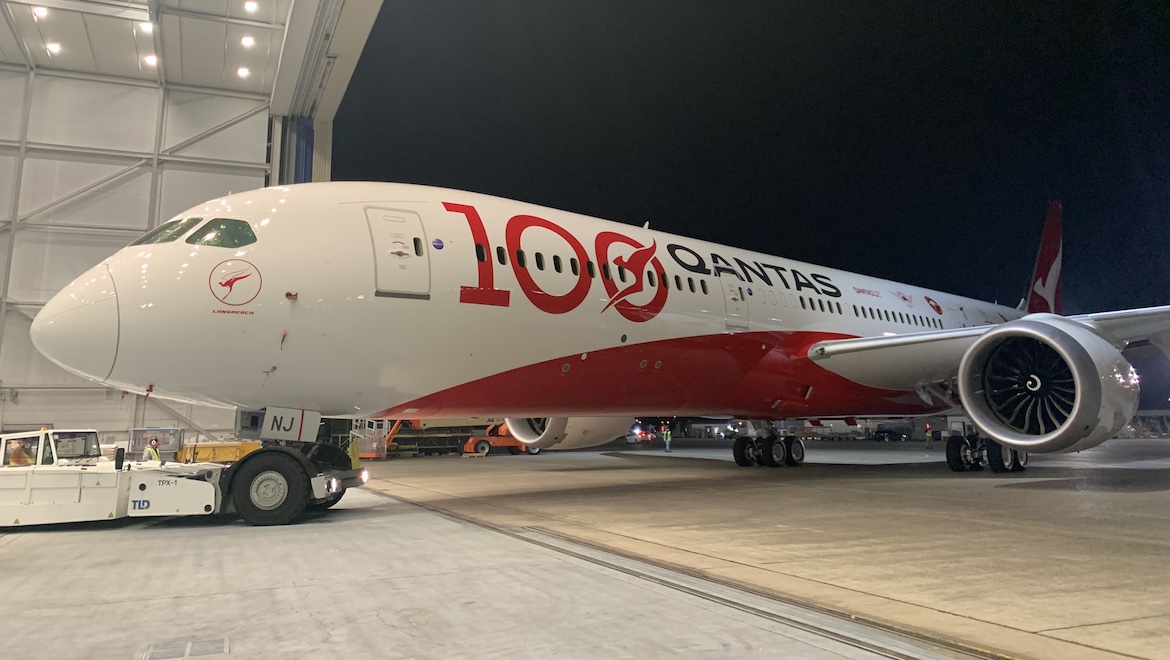
Qantas has released pictures of its soon-to-be-delivered 10th Boeing 787-9 that features a special livery celebrating the airline’s upcoming centenary in 2020.
The 787-9 VH-ZNJ Longreach has emerged from the paintshop at Boeing’s Everett facility, Qantas said in a statement on Tuesday (Australian time).
The fuselage features the number 100 that incorporates the flying kangaroo logo forward of the wings.
It also has the airline’s different logos since its foundation as the Queensland and Northern Territory Aerial Services (QANTAS) in 1920.


“The story of Qantas is the story of modern Australia, and the logos on this livery tell that story from the beginning,” Qantas chief executive Alan Joyce said in a statement on Tuesday.
“Our centenary celebrations are all about honouring our past with an eye on the future, so it’s very fitting that this special livery will be worn by our newest state-of-the-art Dreamliner.”
Qantas said the aircraft would be handed over to Qantas in November and would then be ferried to London to operate the second of three Project Sunrise research flights. [vc_gallery interval=”0″ images=”78609,78612,78610,78613,78611″ img_size=”750×420″ title=”Boeing 787-9 VH-ZNJ (Images from Qantas)”]
The first of these research flights, which aimed to test different approaches to crew and passenger wellbeing for Qantas’s proposed ultra-long haul services, was due to occur on Friday, October 18, when 787-9 VH-ZNI was scheduled to fly nonstop from New York JFK to Sydney.
Flight QF7879 was due to take off from New York JFK at 2100 local time on Friday and land at Sydney at 0710 two days later.
The aircraft operating the ultra-long haul sector, VH-ZNI Kookaburra, had its first flight on October 3, according to Jennifer Schluld’s Twitter page. It then had another test flight on October 9.
Qantas brand new 787-9 VH-ZNI taxi test and first flight today from PAE to MWH.
This 787-9 is named “Kookaburra”. pic.twitter.com/bAqG0Av5R7— Jennifer Schuld (@JenSchuld) October 3, 2019
Qantas 787-9 VH-ZNI back at PAE after a test flight to MWH this afternoon pic.twitter.com/15wYVbNJoD
— Jennifer Schuld (@JenSchuld) October 9, 2019
There were only 40 people expected to be on board QF7879, comprising researchers from Monash and Sydney universities, as well as chief executive Alan Joyce and other Qantas staff alongside invited media.
From a pilot’s perspective, Qantas Captain Lisa Norman said in August the research flights would aim to replicate what a pilot would experience on a typical rostering pattern that included these ultra-long haul routes.
“We will try and accomodate a normal pattern for the pilot,” Captain Norman explained to Australian Aviation at Qantas’s 2018/19 full year results presentation on August 22.
“So the pilot will fly from maybe Brisbane or Melbourne up to Los Angeles for example, they will have their rest that we do now. They will fly to New York, they will have the rest that they do now. And then we will do the New York-Sydney.
“We are monitoring all this preflight, in-flight and post flight.
“About a week beforehand we will probably start testing the pilots and their sleep patterns and asking them questions and things like that.”
New York-Sydney measured 8,646nm, according to the Great Circle Mapper, while London-Sydney was 9,188nm.
Both routes were expected to take 18.5 hours, according to figures from Qantas.
The Boeing website listed the 787-9 with a range of 7,530nm when configured with 296 passengers. However, with about 40 people on the flight, Captain Norman said there was “no question of it doing the sector”.
The airline said the pilots would wear an electroencephalogram to track brain wave patterns and monitor their alertness.
Meanwhile, from a passenger perspective, Qantas said scientists from Sydney University’s Charles Perkins Centre would monitor sleep patterns, food and beverage consumption, lighting, physical movement and inflight entertainment to assess impact on health, wellbeing and body clock. The passenger would also be wearing technology devices.
Qantas has said previously it was aiming to make a decision whether to proceed with Project Sunrise and make an aircraft order by the end of calendar 2019.










